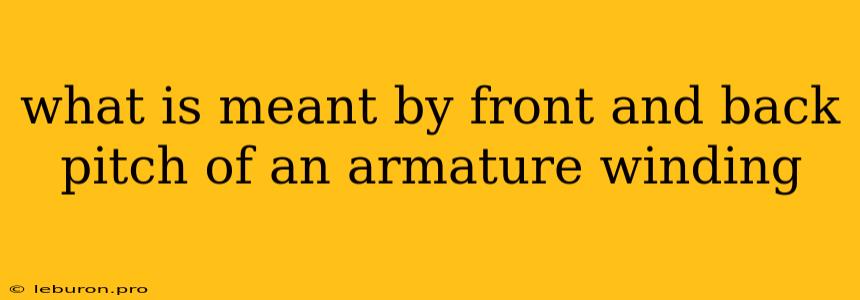The efficient operation of electric motors and generators hinges on the precise configuration of their armature windings. A critical aspect of this configuration is the front and back pitch of the winding. These parameters determine the direction of current flow through the armature conductors and significantly influence the motor's performance characteristics. This article delves into the intricacies of front and back pitch, explaining their significance and how they contribute to the smooth and efficient operation of electrical machines.
Understanding Front and Back Pitch
The front and back pitch of an armature winding are terms that describe the relative positions of adjacent coil sides within the armature slots.
Front Pitch (Y<sub>f</sub>)
The front pitch is the number of armature slots spanned by a single coil side as it traverses from one slot to the next on the front or commutator end of the armature.
Back Pitch (Y<sub>b</sub>)
The back pitch is the number of armature slots spanned by the same coil side as it traverses from one slot to the next on the back or shaft end of the armature.
The Importance of Front and Back Pitch
The front and back pitch directly influences several crucial aspects of armature winding behavior, including:
- Direction of Current Flow: The pitch determines the direction of current flow through the armature conductors. A properly chosen pitch ensures that the current flows in a pattern that produces the desired magnetic field, generating the necessary torque in a motor or voltage in a generator.
- Commutation: The pitch plays a vital role in achieving smooth commutation, which is the process of transferring current from one brush to the next as the armature rotates. Incorrect pitches can lead to sparking and damage to the commutator and brushes.
- Magnetic Field Distribution: The front and back pitch influences the distribution of magnetic flux within the armature. A well-designed pitch ensures a symmetrical and balanced magnetic field, leading to efficient energy conversion and reduced losses.
Types of Windings Based on Pitch
The front and back pitch are key factors in determining the type of armature winding used. Some common winding configurations include:
- Lap Winding: In a lap winding, the front pitch (Y<sub>f</sub>) and back pitch (Y<sub>b</sub>) are almost equal, typically differing by one slot. This results in the coil sides of a single coil being positioned adjacent to each other in the armature. Lap windings are characterized by a high number of parallel paths, making them suitable for low-voltage, high-current applications.
- Wave Winding: In a wave winding, the front pitch (Y<sub>f</sub>) and back pitch (Y<sub>b</sub>) are significantly different. The difference between these pitches is often two or more slots. This arrangement leads to coil sides being positioned in a zig-zag pattern within the armature. Wave windings have fewer parallel paths, making them ideal for high-voltage, low-current applications.
Calculating Pitch
To calculate the front and back pitch of an armature winding, the following formulas can be used:
- Front Pitch (Y<sub>f</sub>) = (Number of slots per pole) - 2
- Back Pitch (Y<sub>b</sub>) = (Number of slots per pole) + 2
These formulas are for a simplex lap winding. Other winding types may have different formulas.
Determining Pitch for Specific Applications
The choice of front and back pitch depends on the desired characteristics of the motor or generator. For example:
- High Torque Applications: Lap windings with a high number of parallel paths are often preferred for high-torque applications, as they can handle high currents.
- High Speed Applications: Wave windings with fewer parallel paths are typically used for high-speed applications, as they have lower losses and can handle higher voltages.
Conclusion
The front and back pitch of an armature winding are fundamental parameters that play a crucial role in the performance of electric motors and generators. Understanding these parameters and their influence on the direction of current flow, commutation, and magnetic field distribution is essential for designing and operating these machines efficiently. By carefully considering the front and back pitch during the design phase, engineers can optimize the performance and reliability of electrical machines for a wide range of applications.
